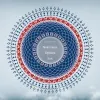Take a look inside 4 images
Engare
Pros: Rewards thoughtful play and mesmerizes the player with intricate patterns inspired by Islamic art.
Cons: Can be frustrating if the player becomes stuck; most solutions just click into place, but sometimes the click doesn't happen easily.
Bottom Line: Play for the surprising geometry and beautiful art; consult the web or just walk away for a while when stuck.
Engare can be played individually or maybe in pairs. Each level is an animated puzzle with geometric shapes and patterns. It might be possible to ask students to draw solutions before trying them out in the game, but that might bog down its quick nature.
An advanced geometry and trigonometry course could ask students to calculate curves and predict movements of each of the puzzles. This would take some setup and initial playing by the instructor to figure out which levels were best suited for this, but it's probably doable. An art or art history class could introduce students to Islamic art and then let students explore themes and shapes through playing the game. The website for the game offers a separate drawing tool that's based on the game, too!
Engare is a slow-paced yet quick puzzle game with beautiful, simple geometry-like graphics and atmospheric music. It's not like a normal game. It sort of is in the sense that it has levels and challenges, with each level providing a small new challenge (that upon solving unlocks the next level). It has the trappings of a casual puzzle game like that, but the content is quite mind-blowing and different. The puzzles are in trying to figure out how to draw particular lines by tracing the motion of various objects that rotate around different points, like a spirograph. The patterns are beautiful and extremely intricate but come from very simple motions. Complexity through simplicity. And LOTS of surprising patterns.
Solving individual puzzles takes a few contemplative moments and is rewarding. Once solved, the game immediately offers the next puzzle, which means it's fairly easy to lose track of time, solving puzzle after puzzle for a while. The only downside to all of this is when a player gets stuck. The immersion is broken as the frustration increases sharply. Luckily, answers to puzzles are easily found online, but it's extremely flow-breaking to have to stop and hop over to a web browser to search for an answer. It's these times when the player may just decide to stop for the day, or forever, instead.
There are four main lessons to be learned from Engare. First, at its most basic level, Engare is a puzzle game where players recognize artistic patterns within simple motion machines. This is something that takes time and practice to get the hang of since the puzzles are so novel, but it's essentially about making sense in noisy systems. Second, the noisy systems in Engare are geometric and shapes-based; understanding them feels like opening a third eye toward mastery of some sort of arcane geometric Truth. It's akin to mastering the language of math like Dr. Strange mastered the mystic arts, except it's a visual language of intricate formulae that are being understood. When it makes sense, it just clicks in that way that the player's whole body feels. Third, these shapes and lines are inspired by Islamic art, so it's possible for the player to be further inspired to research Islamic art and learn about its cultural and historical roots. The opportunity for this tangential learning is significant with Engare.
Lastly, Engare really asks the player to exercise patience. It's a meditative game that rewards thought before action, but what's interesting is that it also rewards an iterative approach to puzzle solving. If something doesn't work, the game provides good and immediate feedback so that players can learn from their prior attempts to trace lines in the noisy machines. Yet players have to think about this feedback -- this new information -- and incorporate it into their model of how the current puzzle works before acting again. So, it's not a rapid-fire click, click, click until the player succeeds, but more of a click, watch, reflect, think, surmise, notice, think some more, click. Indeed, this a great game to play on a cold day with a hot beverage. Slow and methodical, with long sips of coffee or hot chocolate, through quick, short levels of intricate patterns from simple designs.












